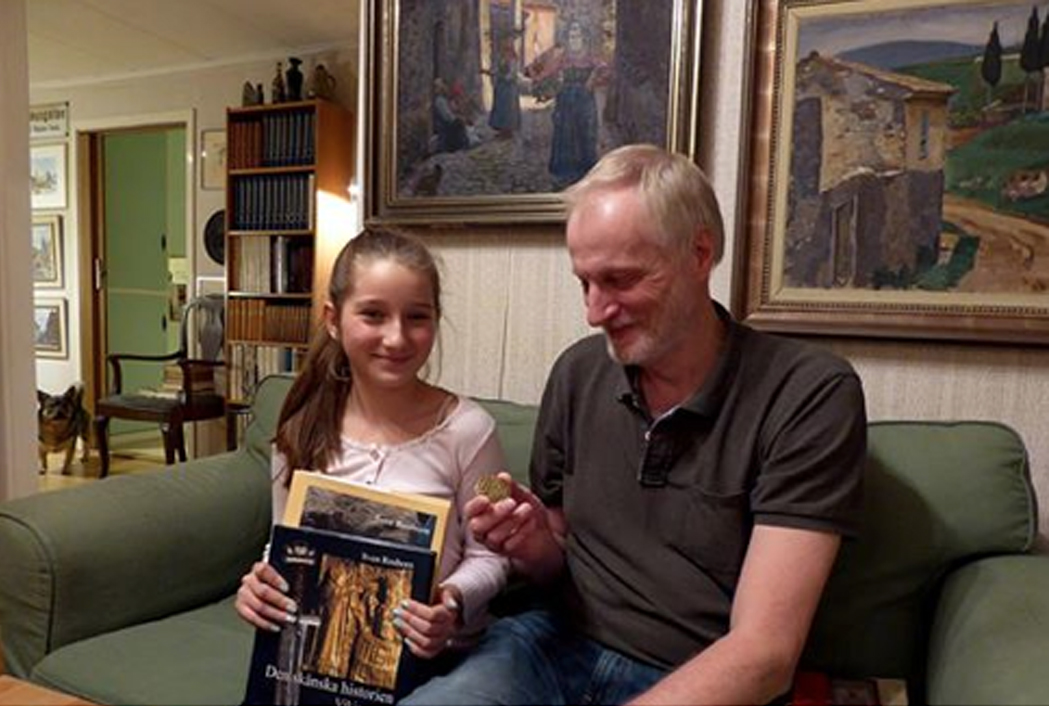A strange golden object with an inscription about the Danish Viking King, Harold Bluetooth, has resurfaced from an old box brought from Poland in the aftermath of WW2
One day, a Swedish teacher inspired a student of hers – a girl of Polish heritage to bring a “golden” disk along, which was kept in a box containing other bits and pieces brought from Poland after WW2 by her great-grandmother. Luckily, the teacher was smart enough to contact Sven Rosborn, archaeologist and former curator at Malmö Museum and Foteviken; and known for his engaged and learned approach towards the Early Medieval History of Scandinavia. Soon, a Danish/Swedish debate erupted as to the authenticity of the find.
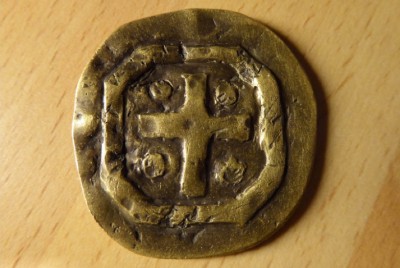
Whether authentic or not, the object is in itself decidedly odd and would – even if fake – raise a number of questions. These have been carefully considered in a 12-page long essay in Swedish by the archaeologist, Sven Rosborn [1], who has had the opportunity to study the object in detail. The following exposé builds on his work as well as tries to make a minor contribution in the form of an alternative explanation as to form and function. However, the field is decidedly not covered and we still lack a more detailed technical and philological examination by scholars and scientists.
We need this because the object – if genuine and authentic – contributes significantly to our knowledge of what happened in the last days of the reign of Harold Bluetooth (c. AD 930 – 987). If a fake, we need to be assured of that and perhaps get to know more about the history behind the ideas, which caused someone to cast such an intriguing plaque (with apparently no original model).
The aim of the following short presentation is meant to provide a context for the ongoing buzz.
Description
The object is a round golden disk/plaque/medallion/talisman/amulet measuring 4,5 cm in diameter and with a weight of 25,23 gr. It is definitely not a coin, being cast and not struck.
On the obverse side it is covered with an inscription in Latin with place-names in Saxon.
On the reverse side there is a cross with bullets, placed inside an elevated ring; a design, which is very close to the reverse design on German coins from the 10th century.
The general impression from published photos generously provided by Sven Rosborn, is that it looks as if it is a rather crude object, obviously made in a “non-viking” context. Harold was as a matter of fact known for his support of bold architecture as well as delicate and exquisite pieces of handcrafted boxes, swords and jewellery, characterized by his special design: the jelling-style [2]. This object has quite another character.
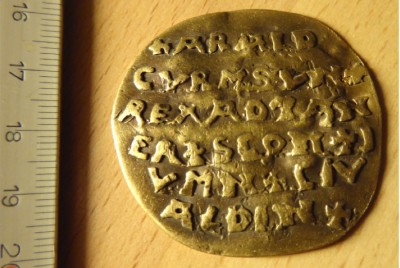
On one side of the object, there is an inscription, which says:
HARALD
CVRMSVN+
REX AD TAN
ER+SCON+J
VMN+CIV
ALDIN+
In translation:
Harold
Gormsson +
King to the Dan
es + Scania + J
umna + City
Oldenburg +
Or more straight forward: Harold Gormsson [commonly known as Harold Bluetooth], king to the Danes, Scania(ns), Jumna(ns), City of Oldenburg)
Recently KarAna Âdelmetall in Helsingborg in Sweden did an analysis of the gold (x-rays of five points, three on the front and two on the back). It appears that the object has been made of an alloy of 91 – 92% of gold mixed with silver, iron, copper, zinc and lead. Later analysis has shown the disk was cast.
The Context
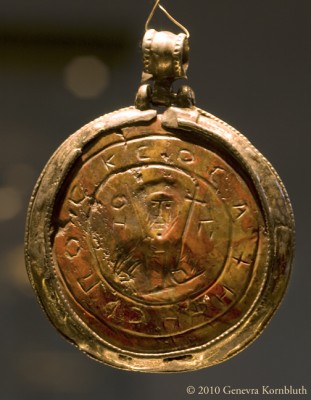
The object is part of a collection of other objects: a silver-coin from the time of Otto I (Holy Roman Emperor AD 912 – 973), fragments of what might be two bronze arm-rings and another small piece of gold.
It is obviously not a coin, although the reverse side with the cross does look very much like the reverse side of a coin. Nor does it look anything like a bracteate or medallion, since it lacks an eye-loop. However it might have been embedded into a design like the one used on the so-called Seal of St. Servatius in Maastrich. Here, an intaglio was fitted into a wrought casing of gold. Encased in the same manner, it may have functioned as a talisman. Further microscopic explorations might uncover if such has been the case.
As to the inscription, this needs a proper philological analysis. A couple of points may be made offhand: 1) the epithet “Tane(r)” is decidedly not the Latin epithet (should be dani, akk. pl. for danus). Instead “taner” exhibits the same spelling as on the large Runic stone at Jelling 2) “Scon” is an abbreviation of the German “Schonen” 3) “Aldin” is the Saxon epithet for “Olden(burg)”. Thus we have a Latin inscription, where the people- or place-names are given in the vernacular (Danish/Saxon).
The Find
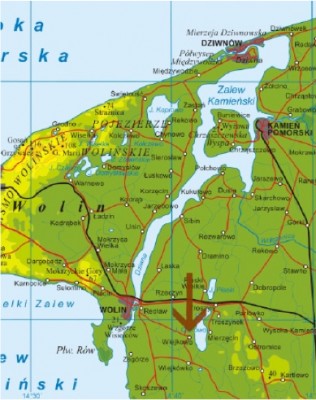 The story behind the discovery reads somewhat like a detective novel. It begins with a young girl, Maja Sielski, who is learning about the Viking Age in a school in Malmö in Sweden in 2015. Inspired by her teacher, Maja inspects a small box, her Polish grandmother has brought to Sweden in the aftermath of WW2. Great is her surprise, when she begins to polish the disk, and discovers that it is made of gold. The family of the grandmother had apparently acquired the artefacts from the local vicar in Wiejkowo, three km from Wolin (Jumna). He sold them in order to finance his flight from the Russian army. This vicar had inherited them from his predecessors in the vicarage. The story was that the artefacts had surfaced in 1840 together with a treasure trove of Arab coins found beneath the floor of the local medieval church, which was being dismantled. Later the silver-coins were sold, while the rest of the so-called “rubbish” was kept at the vicarage.
The story behind the discovery reads somewhat like a detective novel. It begins with a young girl, Maja Sielski, who is learning about the Viking Age in a school in Malmö in Sweden in 2015. Inspired by her teacher, Maja inspects a small box, her Polish grandmother has brought to Sweden in the aftermath of WW2. Great is her surprise, when she begins to polish the disk, and discovers that it is made of gold. The family of the grandmother had apparently acquired the artefacts from the local vicar in Wiejkowo, three km from Wolin (Jumna). He sold them in order to finance his flight from the Russian army. This vicar had inherited them from his predecessors in the vicarage. The story was that the artefacts had surfaced in 1840 together with a treasure trove of Arab coins found beneath the floor of the local medieval church, which was being dismantled. Later the silver-coins were sold, while the rest of the so-called “rubbish” was kept at the vicarage.
Maja brought the box with its contents to school, and her teacher tentatively identified them as “something worth-while”. Afterwards the family tried to get specialists to look at it. However, it was not before the archaeologist Sven Rosborn was contacted, that a proper study took off (of which the study of the alloy has been but one part). This week Sven Rosborn published a twelve-page essay about the artefact and its possible historical context plus some reflections about provenience and authenticity. The following builds heavily on his careful groundwork.
A Fake?
It is obviously no longer possible to confirm much about the veracity of the story behind the find in 1840; as such the object has to be classified as a “casual” – a technical term denoting “no secure provenience”. Nevertheless, according to Sven Rosborn, the object might just possibly be authentic. His arguments are:
1) If the object was of a later date, it should have been made of a purer alloy. Especially the traces of lead are somewhat peculiar
2) If it was a historicizing fake the inscription is really odd: For instance it should be expected that a forger would have a) used the high-medieval epithet Bluetooth and not Gormsson b) used Runes in stead of Latin script 3) reflected the famous inscription on the Runic Stone in Jelling, which claims that it was ordered by “that Haraldr who won for himself all of Denmark and Norway and made the Danes Christian”. Instead the inscription is written in a latin with names of locations in Saxon, which are absent from the Runic inscription – Scania, Jumna (Jomsborg) and Oldenburg.
3) The knowledge that Harold had anything to “do” with the City of Oldenburg in Northern Germany (se more below) was not known until P. G. Thorsen in 1839 published his find of a Runic Stone in Sdr. Vissinge in Jutland, which claims that “Tove, Mistovoj’s daughter, Wife of Harold the Good, the Son of Gorm, had this stone raised in memory of her mother”. Mistivoy was ruler of the Abodrites, who were overlords of the city of Oldenburg. It was his daughter, Harold had married. But this was not known before the stone was uncovered and the result was published in Danish. It seems nearly impossible that this information had filtered down to the small local village near Wolin in time for a fake to be made, which might be afterwards “discovered” beneath the floor of the church in Wiejkowo.
4) However, if the object is a fake made in 19th century Poland, “the find” ought to have been widely published at that time. The question is: why would anybody design such an elaborate fake and in gold, and afterwards box it away? Especially since the silver coins were sold because of their metal value. It is perhaps more possible that the people who found the medallion or talisman believed that it – due to its alloy – was made of brass and simply discarded it together with what was called rubbish. Perhaps a careful study of local newspapers from that time might shed further light of the circumstances around the find in 1840?
An Authentic Talisman?
It is told by Adam of Bremen (AD c. 1040 – c.1081) [3], that Harold died in Jumne – (probably) near Wolin – after his son, Sweyn Forkbeard had rebelled against him in 987 (at the latest). According to Adam, the king succeeded – although heavily wounded to flee on a ship, which sailed for Jumna. There, he soon died. Earlier sources (The Encomium Emmae Regina) just tell us he died among the “Wends” – the Poles [4]. Later chronicles afterwards claimed he was brought back to Roskilde and interred there in a church there. However, this story is generally believed to have been created by Adam in order to launch Harold as a future saint [5].
The golden object might thus just possibly have been a talisman or memorial plaque, buried either with the king or one of his men in the small rural church in 987 located outside Wolin. But when was it made? And how should we understand the inscription
Harold Gormsson

Danish history in the 10th century is generally marked by a critical lack of sources. Much of what we seem to know is the result of archaeological excavations, where new finds tend to shift our general understanding from time to time. So-far (as far as anything may be certain) this is a short exposé of what we presently believe at this point:
We don’t know precisely when Harold was born. And we don’t know whether he was co-ruler with his father Gorm the Elder before the latter died in (probably) AD 958. What we do know, though, is that the Scandinavian “kings” from app. 890 and probably even earlier were heavily involved in what has been termed the second Viking Age, characterised by international expansion and later consolidation of Viking dominions in England (the Danelaw), France (Normandy), Russia (Staraja Ladoga, Novgorod and Kiev). This expansion was financed with the surplus generated from trade with the Arabs (plus of course the occasional looting). In the beginning, we get only unverifiable glimpses of how it all came about. Can we for instance believe that that the expansion into Normandy ca. 880 – 920 was undertaken by a scion of the Danish royal family, Rollo, but was orchestrated via England?
But we do get a precise feeling for how this was thought of by the contemporaries, when the German Chronicler, Widukind, wrote about a war, which the German King (later Emperor), Otto the I, and the French King, Louis IV, waged on Normandy in 944. Widukind told, how the German King went to Rouen, “the city of the Danes” (…Ruthun Danorum urbem adiit) [6] Perhaps Harold was even sojourning in Normandy at that time, partaking in the hostilities. This at least is the rumour, which Dudo of Quentin passes on to us 70 years later. He tells that Harold was temporarily in charge of defending the rights of the young heir in Normandy, after his father, William Longsword, had been killed in 942. Historians usually characterize this as wishful thinking on the part of Dudo (it might have been another high-ranking Dane, which was one of the guardians of the young duke, which Dudo then conveniently renamed “Harold” in order to please the Danes in general) [7]. However, a Danish warlord named Harold was mentioned in some contemporary annals, making it a likely story. Also, Rouen was definitely an important investment (a huge slave-market) taken over an rebuilt by Vikings from North Eastern England (Danelaw) and perhaps also wider Scandinavia (Denmark). It is probably pertinent to mention here that he royal family in Denmark at least shared some names with those sported by the Viking rulers in England. The Scandinavian warlord, Guthrum (+ c. 890) thus carried the same name as the father of Harold, Gorm (or Wurm). Another connection is the identification of Gunnhild, the wife of Eric Bloodaxe, King of York, who was said to have been a sister to Harold Bluetooth. Hardeknud (Airdeconut) is another such name.
Dannevirke

If the royal involvement in the defence of Normandy in the 940s might be mere speculation, the investment in a major reworking of the old system of fortifications in the 960s called Dannevirke, located at the foot of Jutland is not. Here, where the extremely wealthy Viking emporium, Haithabu, was located, only a 30 km stretch of land is passable. The latest excavations have shown that some fortifications existed already in the 5th century, while the last time the wall was fortified and manned was during WW2. In between a remarkable series of re-workings were carried out; one of these was obviously initiated by Harold. It has been estimated that the building of the so-called “Ko-Vold” required the work of 60.000 days – or 2000 men working for a month [8].
This reworking of Dannevirke is generally paired with other remarkable feats of engineering – for example the construction of the Viking Fortresses in Aggersborg, Fyrkat, Nonnebakken, Trelleborg, and Vallø as well as a series of other less well-understood fortifications along the West coast of Sweden. At the centre of this effort was Jelling, a highly complex royal centre in middle of Jutland.
Jelling
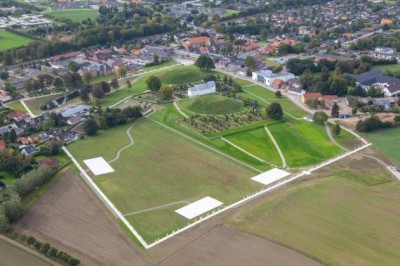
Gorm and his son Harold are primarily known for their monumental effort in Jelling, where they created an absolutely breath-taking memorial for themselves and their family (Jelling is a World Heritage Site). It is a complicated site to understand, not least because archaeological excavations have been carried out for several hundred years and even those carried out in the 1980s were never published in a satisfactory manor. Added to this should be the fact that a church was very early on built on site and continuously rebuilt. The stan ding church– dated to the 12th century – is furthermore encircled by a huge graveyard still being used by the locals. It stands to reason that further excavations are fraught with complications.
However, for the last 6 years a major archeological and interdisciplinary effort has really changed the understanding of the gradual transformations of the memorial during the 10th century (a major publication is underway).
As of today we believe, we know, that Gorm was perhaps responsible for the first monument at Jellinge, a 360 meter massive ship setting. The stone, which Gorm erected to honour his wife carrying the text: “King Gorm made this monument in memory of Thyra, his wife, Denmark’s adornment”, might originally have been located as the main stone at the end of this ship-setting. (But the ship setting might be earlier)
At the exact centre of this ship-setting, we find the large northern mound, generally believed to have been used for the burial of Gorm and dendrochronologically dated to 958 (although this mound was originally known as “Thyra’s mound”). It is slightly possible that it was originally erected for her, and perhaps later “reused” in 964-5 for Gorm. Later additions were a second mound, the large Runic stone erected by Harold, the building of a hall or church between the mounds, a massive fortified palisade around the compound and a number of so-called Trelleborg-houses aligned with the wall.
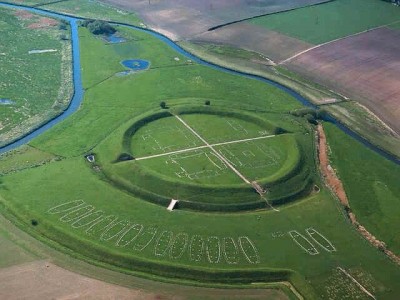
The recently found palisade merits the most attention. Sturdy and well-built, the sides of the rhombic palisade measured app. 360 m and were very nearly the same length as the assumed ship-setting. This palisade enclosed an area of c. 125.000 m2. Calculations show that the palisade would have consumed in the neighbourhood of 1100 oak-trees of more than a hundred years old. It has been dendrochronologically dated to have been erected around 968. As the system of measurements used in the construction and layout of the compound is identical with that used in the construction of the ring-fortresses, we may assume that the palisade at Jelling was the first of these fortifications, which have been dated to 980 – 981. Jelling was perhaps the first in a string of fortifications, now primarily understood as defensive in character – places, where supplies might be gathered and stored. This conclusion fits the curious lack of archaeological finds inside the otherwise very well-built trelleborg-houses in the compounds. Of course a place like Jelling did not only have a defensive function; but it must have been an important element [9].
We may conclude that in the 960s Harold was prepared to defend his realm and its important trading-posts – Haithabu and probably also his own trading-post, Jumna – against the Germans.
War with Germany
South of Dannevirke, Denmark bordered to Saxony, homeland of the German King/Emperor, Otto the Great (ruling from 936 – 973). His kingdom reached from Dannevirke in the North to the South of Bavaria; later, Italy was conquered. We know that war was waged in that region in the 930s and we know that the wall at Dannevirke was breached in 973 and that Haithabu was taken over by the Germans. We also know that it was recaptured ten years later with the help of the Norwegians.
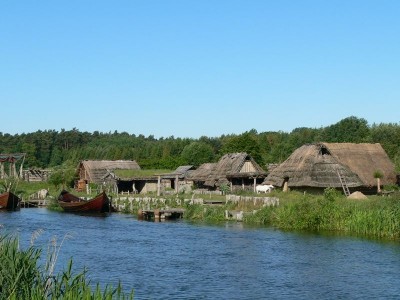
More pertinent to the story of the golden disk, though, is the fact that bordering on Saxony to the East was a Slavic enclave peopled by the Obodrites, who were on and off paying tribute to the German king. Their main town was Mecklenburg, which was ruled by Nakon. He was partly subdued in the battle of Raxa in 955 by Otto the Great and compelled to accept Christianity. Around this time the history gets very complicated.
In 961 the German King took his army into Italy in order to conquer Northern Italy and be crowned emperor in Rome. At the same time strife broke out between the Markgreve (duke) of Saxony and his nephew, who allied himself with some Slavic rebels. During this period we are told the rebels tried to ally themselves with the Danish king Harold. It is safe to presume that it is in view of this, the Archbishop Bruno (de facto in charge of Germany during the Italian campaign of his brother, Otto the Great) sent Folkmar, his closest counsellor to Harold in Denmark in order to secure his allegiance. This Folkmar, later called Poppo, was according to the Chronicler Widukind of Corvey responsible for the baptism of Harold, which we may presume (with Michael Gelting [10]) took place in the spring of AD 963. Perhaps, around the same time Harold married the daughter of Mistovoj, the heir to Nakon. Later in 967 the Saxon duke, Hermann Billung besieged the city of Oldenburg together with Mistivoi, and burned it down. Afterwards a bishop was appointed and installed. It is perhaps from this time we may presume that Oldenburg – Civ Alder” – could boast of being a “Civitas”, the place where a bishop reigned and his cathedral was located [11]. However, the sources are not precise, and it may be earlier. Archaeological excavations in Oldenburg have demonstrated the existence of a very early church, which was even fitted with a bell and which was burned in 967 [12]. Later Harold went to war together with Mistivoj and threw the Germans out of Haithabu.
Questions
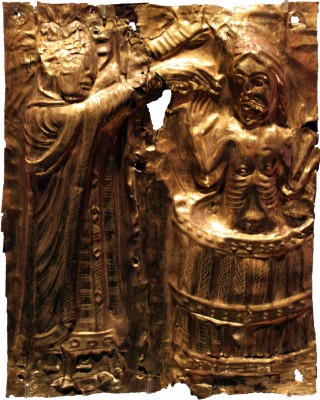
If the talisman is authentic, it might very well be dated from this period after 963, when Harold was baptised, seems to have married Tove, the daughter of Mistovoi, and allied himself with the Obodrites. However, in that case the disk cannot be much later than 975, when Harold began his quest to conquer Norway.
But it might also be very late (from after 986) when – according to Heimskringla – Harold lost to the Norwegians at the battle of Hjörungavik. At this battle the Jomsvikings (vikings from Jumna) were said to have taken part. Perhaps it was at this battle, Harold was wounded and had to flee and ended up in Jumna. (All this is however extremely speculative and builds on a series of sources, all of which are of a late date). This might indicate that the disk was made in Jumna (Wolin) at the time of his death and placed in the grave as a memorial plaque. Hence the lack of “Norway” as part of his realm.
This is the explanation offered in the article by Sven Rosborn, who has examined the object and written the first presentation of it. At this point no explanation can be ruled out. However, it does seem somewhat odd. Why produce a local “Saxon” memorial in a Slavic or Viking environment?
However, if the earlier date is preferred another and perhaps more reasonable explanation may be hypothesized: Perhaps the plaque is not a plaque, but rather a medallion or talisman, which was encased like the “Seal of St. Servatius”, mentioned above. Perhaps it was made as a gift to the king in Mecklenburg or Oldenburg in connection with his wedding in the 60s – after his baptism and before he began to conquer Norway; something which fits rather well with the somewhat worn look, which the golden object seems to have. Perhaps the king was laid to rest with this talisman by his faithful followers. As Sven Rosborn concludes: We may at least now know where the king was buried, even though he was afterwards translated to Roskilde, Jelling or elsewhere.
The question still remains, though: fake or not? The jury is still out…
Karen Schousboe
Postscript
I wish to express my heartfelt thanks to Sven Rosborn for having opened up for the scientific discussion of what might in fact be a sensational find. Also, the find is currently (2021) awaiting its official publication.
NOTES:
[1] Ett unikt object från Harald Blåtands tid?
By Sven Rosborn
Published on academia.edu as a first report – English Translation is available
[2] Viking Art in European Churches. By Else Roesdahl.
In: Viking Trade and Settlement in Continental Western Europe. Museum Tusculanum Press 2010
[3] Adam af Bremens Krønike.
By Allan A. Lund (Translation into Danish and with commentary)
Wormianum 2000
ISBN: 87-89531-01-9
[4] Encomium Emmae Reginae.
Ed. by Alistair Campbell witj a supplementary introduction by Simon Keynes. Cambridge University Press 1998.
[5] Harald Blåtands død
By Niels Lund.
Roskilde Museums Forlag, 1998.
ISBN: 87-88536-36-7
[6] “…Ruthun Danorum urbem adiit” (he went to Rouen, the city of the Danes, Res gestae Saxonicae III, 4. In: Widukind von Corvey. Res gestae Saxonicae/ Die Sachsengeschichte. Latein/Deutsch. Übersetzt und herausgegeben von Ekkehart Rotter and Bern Schneidmüller. Stuttgart, 1981.
7] De moribus et actis primorum Normanniæ ducum.
Mémoires de la Société des Antiquaires de Normandie 23. Ed. by Jules Lair. Caen, 1865. p. 245 Apostropha 4
[8] Danmarks Oldtid. Yngre Jernalder of Vikingetid, 400 -1050 e. kr.
Vol 4, p. 395 – 97
By Jørgen Jensen
Gyldendal 2004
[9] The Late Viking-Age Royal Constructions at Jelling, central Jutland, Denmark. Recent Investigations and a suggestion for an interpretive revision.
By Mads Kähler Holst, Mads Dengsø Jessen, Steen Wulff Andersen and Anne Pedersen.
In: Praehistorische Zeitschrift 2012, Vol. 87 (2): 474 -504
A palisade Fit for a King: Ideal Architecture in King Harald Bluetooth’s Jelling. By Mads Dengsø Jessen, Mads Kähler Holst, Charlotta Lindblom, Niels Bonde aand Anne Pedersen.
In: Norwegian Archaeological Review 2014, 47:1, 42 – 64.
[10] Poppo’s ordeal: Courtier Bishops and the Success of Christianization at the Turn of the First Millenium.
By Michael Gelting.
In: Viking and Medieval Scandinavia 6 (2010) p. 101 – 33
[11] Stad, skrift och stift. Några historiska inledningsfrågor.
By Tore Nyberg
Stockholm 1984
[12] Starigard Oldenburg. Geschichte und archäeologische Erforschung der slawischen Fürstenburg in Wagrien By Karl-Wilhelm Struve. Oldenburg 2010
Further notes may be found in the article by Sven Rosborn
